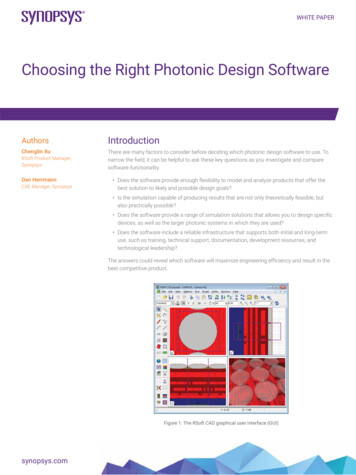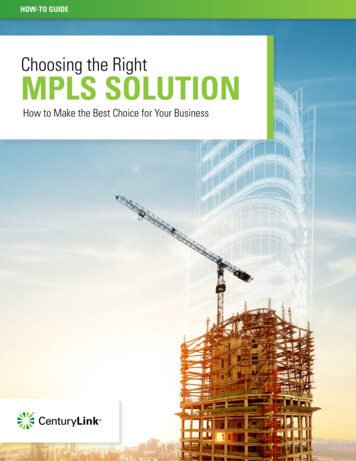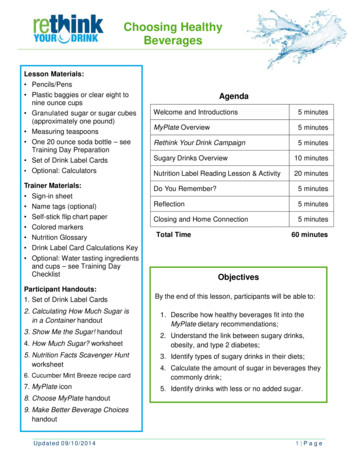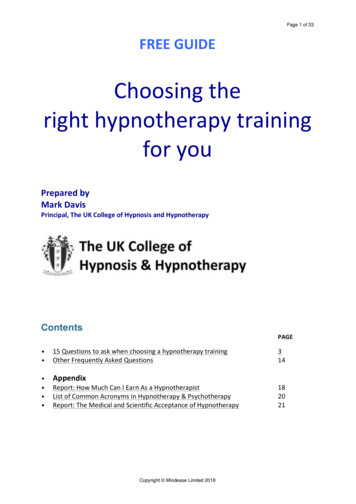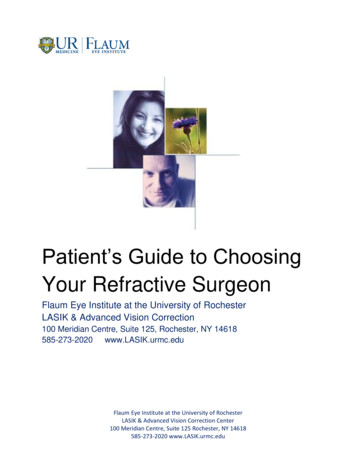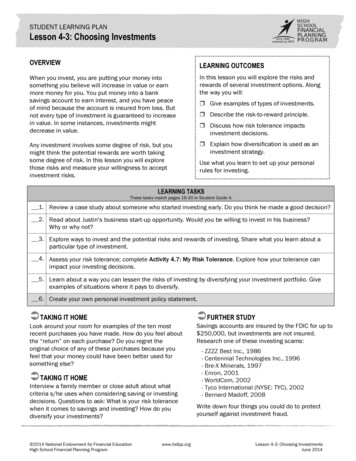
Transcription
Choosing a High-QualityMedical Rehabilitation Program:AN NRH FIELD GUIDE FOR PEOPLE WITH DISABILITIES
Choosing a High-QualityMedical Rehabilitation Program:AN NRH FIELD GUIDE FOR PEOPLE WITH DISABILITIESTO DOWNLOAD A PDF VERSION OF THIS GUIDEBOOK, GO TO WWW.NRHRESEARCH.ORG/CHDR/REHABGUIDEOR WWW.BU.EDU / HDR/CONSUMERGUIDE.PDFFOR ADDITIONAL COPIES OR FOR COPIES IN ALTERNATIVE FORMATS, CALL 1-866-380-4344.
ACKNOWLEDGEMENTSThis guidebook was developed with a grant awarded to the Health & DisabilityResearch Institute at Boston University from the National Institute on Disability andRehabilitation Research (NIDRR): Rehabilitation Research and Training Center forMeasuring Rehabilitation Outcomes, Grant No. H133B990005.The creators of this guidebook acknowledge and thank Paul Rao, PhD, andMichelle Rives, MPH, who were the authors of the National RehabilitationHospital’s publication, A Consumer Guide for People with Stroke: Choosing aRehabilitation Program, on which this guidebook is largely based.We would also like to thank the following individuals for their time and efforts inreviewing this guidebook and providing valuable consumer feedback: Marcus Bell,Bertha Joachin, and Robert Sevigny, in addition to all of the other reviewers fortheir insightful comments, time, and energy.This guidebook was prepared by Melinda T. Neri at the National RehabilitationHospital Center for Health and Disability Research in Washington, DC and designedby Flannery Studios in Montgomery Village, MD.
CHOOSING A HIGH-QUALITY MEDICAL REHABILITATION PROGRAMContentsINTRODUCTION . . . . . . . . . . . . . . . . . . . . . . . . . . . . . . . . . . . . . . . . . . . . . . . . . . . . . . .1PART 1: MEDICAL REHABILITATION . . . . . . . . . . . . . . . . . . . . . . . . . . . . . . . . . . . . . . . . .3What is medical rehabilitation and how can it help me? . . . . . . . . . . . . . . . . . . . . . . .3Who will I work with during rehabilitation? . . . . . . . . . . . . . . . . . . . . . . . . . . . . . . . . .5PART 2: HEALTH INSURANCE PLANS . . . . . . . . . . . . . . . . . . . . . . . . . . . . . . . . . . . . . . . .7What rehabilitation programs and services will my health insurance cover? . . . . . . . .7What are some different types of health insurance plans? . . . . . . . . . . . . . . . . . . . . . .7What’s the difference between private and public health insurance plan payers? . . . .8What does Medicare cover? . . . . . . . . . . . . . . . . . . . . . . . . . . . . . . . . . . . . . . . . . . . . .9What does Medicaid cover? . . . . . . . . . . . . . . . . . . . . . . . . . . . . . . . . . . . . . . . . . . . .10PART 3: CHOOSING A REHABILITATION PROGRAM . . . . . . . . . . . . . . . . . . . . . . . . . . . . .11How do rehabilitation programs differ? . . . . . . . . . . . . . . . . . . . . . . . . . . . . . . . . . . .11Will I need more than one kind of program? . . . . . . . . . . . . . . . . . . . . . . . . . . . . . . .16PART 4: QUALITY AND REHABILITATION . . . . . . . . . . . . . . . . . . . . . . . . . . . . . . . . . . . .17What is meant by ‘quality?’ . . . . . . . . . . . . . . . . . . . . . . . . . . . . . . . . . . . . . . . . . . . . .17What are rehabilitation outcomes? . . . . . . . . . . . . . . . . . . . . . . . . . . . . . . . . . . . . . . .17What are some ways quality is measured at the individual level? . . . . . . . . . . . . . . . .19What are some ways quality is measured at the organizational level? . . . . . . . . . . . .21TERMS . . . . . . . . . . . . . . . . . . . . . . . . . . . . . . . . . . . . . . . . . . . . . . . . . . . . . . . . . . .25QUALITY CHECKLISTS . . . . . . . . . . . . . . . . . . . . . . . . . . . . . . . . . . . . . . . . . . . . . . . . .31RESOURCES . . . . . . . . . . . . . . . . . . . . . . . . . . . . . . . . . . . . . . . . . . . . . . . . . . . . . . . .35NRH Center for Health and Disability Researchiii
CHOOSING A HIGH-QUALITY MEDICAL REHABILITATION PROGRAMSTEPS FOR CHOOSING A HIGH-QUALITY REHABILITATION PROGRAMivNRH Center for Health and Disability Research
CHOOSING A HIGH-QUALITY MEDICAL REHABILITATION PROGRAMIntroductionSelecting a high-quality medical rehabilitation program after you experience an injury or illness can be hardto do. You want a rehabilitation programthat will give you the best possible carechoose a high-quality rehabilitation pro-and that takes into account your own cir-gram. It includes four major parts. Part 1cumstances. For instance, you will want adescribes medical rehabilitation—what itprogram that considers how well you getis, how it can help you, and the differentaround, the type of transportation you use,rehabilitation professionals who will workwhere you live, your level of family sup-with you. Part 2 discusses health insuranceport, and your insurance coverage. Youplans so that you can understand whatalso want a program that will help you toyour plan will and will not cover. Part 3become as independent as you can be intalks about the different types of rehabili-your daily living.tation programs available to you, and PartWhen it comes time to choose a rehabilitation program, where do you start? Howcan you tell which rehabilitation programs4 looks at ways that can help you find ahigh-quality rehabilitation program to suityour needs.offer high-quality services that will meetAt the back of this guidebook, you will findyour needs, and which programs will not?a glossary of terms. When you are readingUnfortunately, people often must decidewhere to go for rehabilitation when theydo not have the time to gather detailsabout all available programs. Typically,decisions about which rehabilitation program to use are made when a person isalready in an acute care hospital. If someone has not talked with you or a familythrough this guidebook and see a word inboldface type, you can find out its meaning in the terms section. You can also lookthrough the terms section first, to familiarize yourself with some of the words. Youwill see that next to each word is a pagenumber where it appears in the text, if youneed further descriptions.member within the first few days afterIn addition, you will also find checklists tobeing admitted to a hospital, ask to see ahelp you choose a high-quality rehabilita-hospital social worker. The social workertion program, as well as a listing ofcan help you begin the process of choosingresources including organizations, Weba rehabilitation program.sites, and phone numbers that might beThe goal of this guidebook is to help you toNRH Center for Health and Disability Researchuseful.1
CHOOSING A HIGH-QUALITY MEDICAL REHABILITATION PROGRAMAfter reading this guidebook, you shouldwill be better prepared to choose a pro-have a better understanding of how to findgram that meets your health care needsa good quality medical rehabilitation pro-and helps you to be as independent asgram. By becoming more informed, youpossible.MARTIN’S STORY: THE ROAD TO RECOVERYIn the summer of 1999,Martin was an active 42year-old who rode his bike20 miles roundtrip to workeach day. One weekend, ashe was gearing up for along ride and putting onhis cycling shoes, he suddenly lost all feeling in hisright arm and leg. Therewas no pain, no sickness,no blurred vision—just nofeeling.Martin was taken rightaway to an acute carehospital where he learnedhe had a mild stroke. Twoweeks later, he transferredto a rehabilitation hospitalwhere he could rebuild hisstrength and relearn skillsneeded for independentliving. After his intensiveinpatient rehabilitation,he continued with weeklyoutpatient therapy.2For Martin and others, thechanges that come withdisability can createlifestyle challenges. Medicalrehabilitation helps toidentify each person’s abilities and finds ways to usethose abilities and newskills in daily life.One of Martin’s biggestchallenges after his strokewas learning how to dothings with his left hand,even though he was righthanded. “I had to learnhow to brush my teethwith my left hand. Thatseems simple enough, butit’s been a long, difficultprocess. In the end, it’sbeen worth it to still beable to do many things formyself.”Martin found that confidence, self-esteem, andsupport from family andfriends played a big part inhis rehabilitation andrecovery. “Rehabilitation isabout believing in yourself,knowing that you can getbetter with determination,”he reflected. “It’s not easy,but my family and therapists were very supportive.”After rehabilitation, Martinjoined a stroke supportgroup. This group of strokesurvivors and family members met each month totalk about their experiences. Personal achievements were also shared asa way to inspire others toreach their own personalgoals.Years later and almost fullyrecovered, Martin is still anactive member of thestroke support group. Infact, he now bikes to andfrom the meetings eachmonth.NRH Center for Health and Disability Research
MedicalRehabilitationMEDICAL REHABILITATIONPART 1:
CHOOSING A HIGH-QUALITY MEDICAL REHABILITATION PROGRAMPART 1:MedicalRehabilitationIt’s important to try to understand someto walk on a flat, indoor surface whereof the basic concepts about disability.there are no curbs or steps.To begin with, how well you functiondepends on your health, where and howyou live, and other individual factors.Living with a disability means that yourbody might not be able to function fully. Italso means that you might be limited indoing some tasks or taking part in someactivities.Performance is one’s ability to do a certain task in a real-world setting that mayhave barriers, such as steps, unevenground, or bad weather. Although youmight have the capacity to walk, the environment affects your real walking performance. It makes it harder for you tofunction and plays a part in your disability.Capacity and performance are two termsfunctional ability relates to the conceptWHAT IS MEDICAL REHABILITATION ANDHOW CAN IT HELP ME?of disability. Capacity refers to one’s abil-Treatment for disability or illness mostity to do an activity in a barrier-free place.often begins with acute medical care.For example, you might have the capacityThis medical care usually is provided in anthat can help you understand how yourKERRY’S STORY: THE ENVIRONMENT AND DISABILITYKerry was 19 and workingas a summer house painterwhen he fell from a ladderand sustained an incomplete spinal cord injury.After his injury and rehabiliation, he had a reducedcapacity for walking andneeded to wear braces tohelp him get around.Kerry has been living aproductive and full lifesince the injury. He is ableto function and walk independently with his bracesand uses public transportation to get to and fromwork. However, the physical environment sometimesmakes walking difficult.The environment plays arole in Kerry’s disabilitybecause his walking performance is more limited inNRH Center for Health and Disability Researchbad weather. For example,rains hinders his walkingperformance because thesidewalks get slick. Whenthe sidewalks get slick, it isharder for him to walksafely from the subway tohis office building. Whenit’s not raining and thesidewalks aren’t slick, Kerrydoesn’t have to worry asmuch about falling.5
CHOOSING A HIGH-QUALITY MEDICAL REHABILITATION PROGRAMacute care hospital before you beginMedical rehabilitation can help you to liverehabilitation. Acute medical care seeks toas independently as possible with your dis-stabilize your condition and lessen anyability. It helps to reduce the effects of anyfurtherRehabilitationproblems you may experience after yourbegins after you are stable and yourinjury or illness. Rehabilitation uses a care-doctors think you will have no morefully planned program to help you regaincomplications.your ability to function on your own atcomplications.MEDICAL REHABILITATION IS DIFFERENT FOR EVERYONEThe rehabilitation processis different for everyone. Itdepends on many differentthings, including how youare injured or become ill,how old you are when thishappens, where you live,and the resources and services that are available toyou. Most importantly, italso depends on YOU.Meet Elvira. Elvira was 40years old and living in ruralCosta Rica when sheawoke one night with anupset stomach and stingingpain shooting down herleft arm, coupled with armcramps. When she triedto get up, she found thatshe couldn’t stand. Sheimmediately called foran ambulance, and afterarriving at the hospital, thedoctors told her she had astroke. Elvira was kept inthat hospital for 6 months,receiving very little rehabilitation and not making very6good progress while there.Looking back, Elvira nowknows that in rural CostaRica she wasn’t getting therehabilitation services andprofessional and emotionalsupport that she needed tomake progress. After 6months recovering in CostaRica, Elvira decided tomove back to the UnitedStates so that she couldget the rehabilitaiton servcies she needed. She wouldalso be closer to family andfriends to get the emotional support that she waslacking in her recovery.Once back in the states,Elvira’s first doctor told herthat she was never going towalk again. She knew thathe was wrong and wasdetermined to prove it.Elvira believed she wouldindeed, walk again. Shefound a rehabilitation teamthat provided her with theservices and treatment shewas looking for. Withinmonths, she was makingthe progress that she knewshe was capable of. Beingnear supportive family andfriends, Elvira also receivedthe encouragement andsupport that she neededto help her. She wasnow highly motivatedto improve both herfunctional ability and hercapacity to live and workindependently again.Today, nine years after herstroke in another county,Elvira is able to receiveweekly therapy. She hasbeen working full-time asan Administrative Assistantfor over a year, and commutes to and from workvia public transportation.As she says, “You would besurprised at how fast youcan recover after findingthe right treatment andbelieving in youself thatyou can improve.”NRH Center for Health and Disability Research
Rehabilitation Research (NIDRR): Rehabilitation Research and Training Center for Measuring Rehabilitation Outcomes, Grant No. H133B990005. The creators of this guidebook acknowledge and thank Paul Rao, PhD, and Michelle Rives, MPH, who were the authors of the National Rehabilitation Hospital’s publication, A Consumer Guide for People with Stroke: Choosing a Rehabilitation Program,
